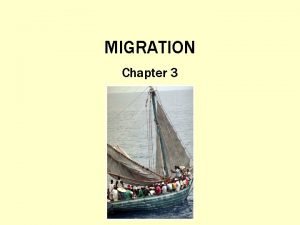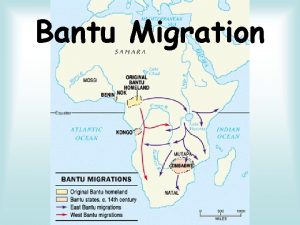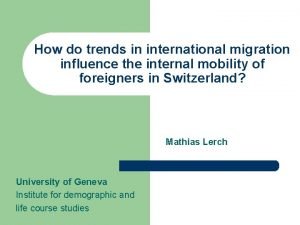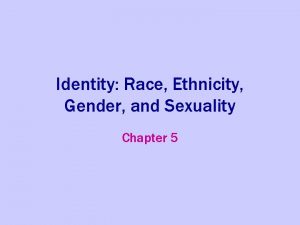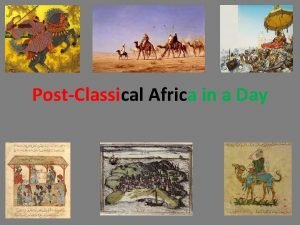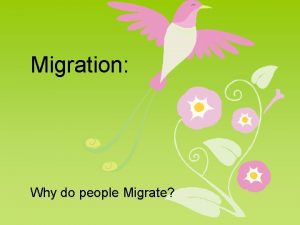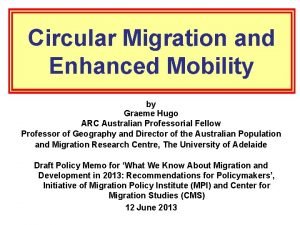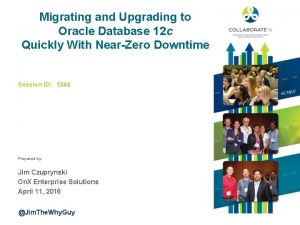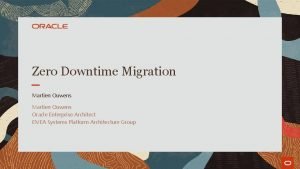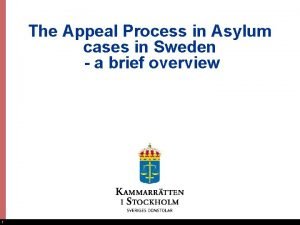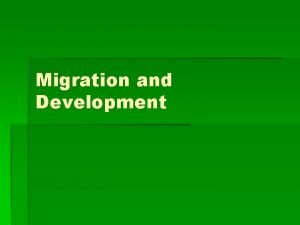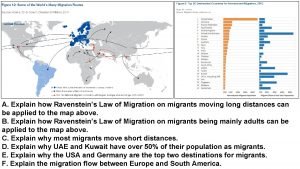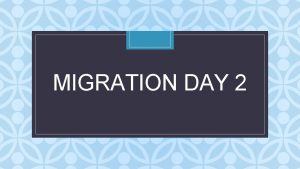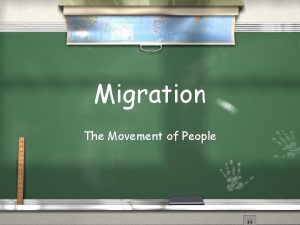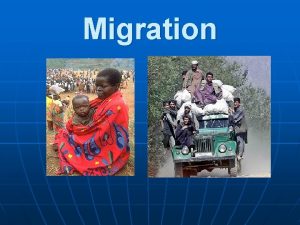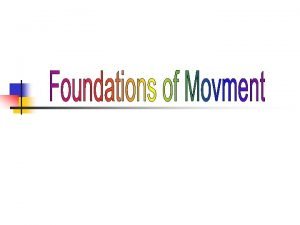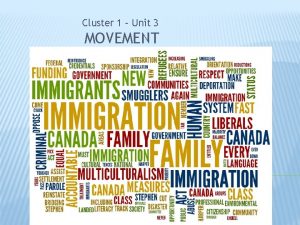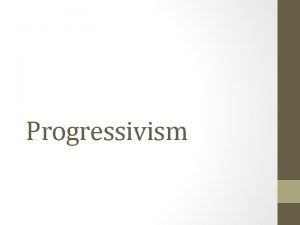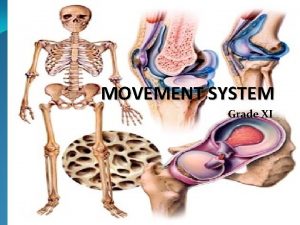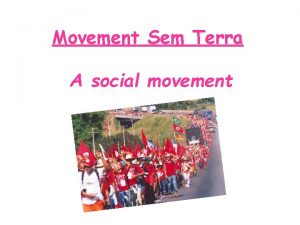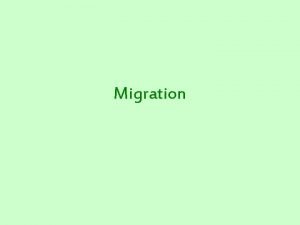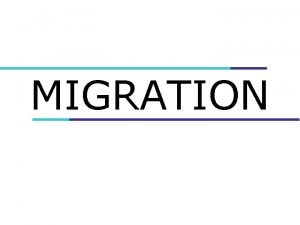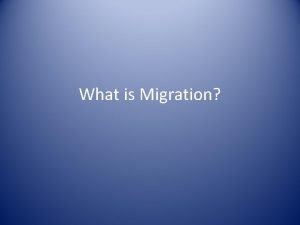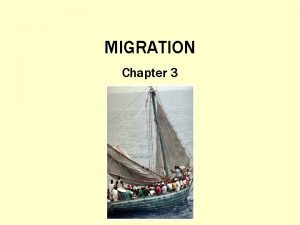MIGRATION Migration l l l Migration Movement of





























- Slides: 29

MIGRATION

Migration l l l Migration Movement of the people for the specific purpose from one place to another in the country or to a foreign country. Emigration Movement of people from one place to another (leaving one’s own country) usually from one country to another with a purpose of earning, living, residing and settling Immigration Movement of a person as a permanent resident into(coming to live) another area/, usually into a foreign country.

Indian Diaspora 1. During Colonial period, millions of people were sent to Mauritius, Fiji and S. Africa from UP, Bihar to work as plantation labourers. All such migrations are covered under the time bound contract known as Girmit Act(Indian Emigration Act), living conditions of these labourers were no better than slaves. 2. The second wave of migrant ventured into the neighbouring countries in recent times as artisians, traders and factory workers to Thailand, Malaysia, Singapore in search of better economic opportunities and trend still continue. 3. Third wave of migrants comprised of doctors, engineers, consultants, financial experts to western world as they enjoy distinction of highest educated, highest earning and prospering group. After liberalisation in the 90 s education and knowledge based emigration has made Indian Diaspora one of the most powerful diaspora in world.

Why people migrate ? STORY Ram Babu, working as an engineer in Bhilai Steel Plant, Chhattisgarh, was born in a small village of district Bhojpur, Bihar. At an early age of twelve he moved to a nearby town Ara to complete his intermediate level studies. He went to Sindri, Jharkhand, for his engineering degree and he got a job at Bhilai, where he is living for the last 31 years. His parents were illiterate and the only source of their livelihood was meagre income from agriculture. They spent their whole life in that village. Ram Babu has three children who got their education up to the intermediate level at Bhilai and then moved to different places for higher education. First one studied at Allahabad and Mumbai and is presently working in Delhi as a scientist. The second child got her higher education from different universities in India and is now working in USA. The third one after finishing her education settled at Surat after marriage.

Migration is Global

Migration based on Census In the Census of India migration is enumerated on two basis: 1. Place of Birth: if the place of birth is different from the place of enumeration than it is known as Life time Migrant 2. Place of Residence: If the place of last residence is different from the place of enumeration than it is called Migrant by place of last residence 3. According to 2001 census, out of 1, 029 million people in the country, 307 million (30%) were reported as migrant by place of birth and 315 million (31%)as migrant by place of last residence.

Types of Migration Internal migration l This refers to a change of residence within national boundaries, such as between states, provinces, cities, or municipalities. International migration l This refers to change of residence over national boundaries. An international migrant is someone who moves to a different country.

International Migrants Are Further Classified ILLegal immigrants are those who moved without moved with the legal permission of the receiver nation Refugees are those crossed an international boundary to escape persecution.

Streams of Migration Under Internal migration four streams are identified as: (a) Rural to Rural (R-R) (b) Rural to Urban (R-U) (c) Urban to Urban(U-U) (d) Urban to Rural (U-R) (1) Intra-state migrants are larger than inter-state migrants, i. e. people prefer to migrate within the state (ii) Intra-state migration is dominated by FEMALE migrants whereas inter-state migration is dominated by MALE migrants. (iii) Female migrates due to the reasons of (marriage)Social reasons whereas Male migrates due to the Economic reasons (iv) Females prefer short distance rural to rural migration whereas male migrate to long distance rural to urban regions


CAUSES OF MIGRATION PUSH FACTORS POVERTY UNEMPLOYMENT LACK OF BASIC INFRASTRUCTURAL FACILITIES SUCH AS HEALTH CARE, EDUCATION, ETC HIGH POPULATION PRESSURE ON LAND NATURAL DISASTERS, WARS , POLITICAL INSTABILITY PULL FACTOR S BETTER EMPLOYMENT OPPORTUNITIES BETTER LIVING CONDITIONS PEACE AND STABILITY PLEASANT CLIMATE



SPATIAL VARIATION IN MIGRATION The internal migration varies from state to state. 1. Maharashtra, Delhi, Gujarat and Haryana have largest numbers of net in-migrants. (These states attract migrants from other states). 2. Largest numbers of out-migrants are from states : UTTAR PRADESH and Bihar. 3. Among the urban agglomeration, Greater Mumbai received the higher number of in- migrants: MAHARASHTRA and Delhi 4. Intra-state in-migrants are largest in Greater Mumbai.

Economic Causes of Migration l Migration in search of better economic conditions, employment opportunities l Migration to escape poor climate conditions such as drought, natural hazards, epidemics, pressure of population on land, poverty etc. l Rapid Urbanization (R-U migration because of pull factors, economic, social and political as well as availability of better basic amenities l Migration to the suburbs in order to secure better living conditions environment free from pollution, free from crowd, peaceful living l Greater Mumbai has the highest number of in- migrant l Bangladesh, Pakistan, Nepal are the largest immigrants by last residence in India

Political Causes of Migration l l l Migration as a result of political un-rest, poor governance in source country/state Forced migration, with or without political Agreement Migration to escape war, invasion, military takeover Examples: Tamils from Sri Lanka during the civil war, Rohingyas from Myanmar, Tibetans to India after Chinese takeover.

Social Causes of Migration l l l Migration to reunite with family, friends who have previously migrated Migration to find personal freedom, to live a certain lifestyle, or to hold certain belief. Migration to spread religion

CONSEQUENCES OF MIGRATION BRAIN STORMING ON THIS TOPIC

Economic consequences Positive consequences: i. A major benefit for the source region is the remittance (payments) sent by migrants ii. Similarly remittances from the international Indian migrants are one of the major sources of foreign exchange in India. In 2002, India received US$11 billion as remittances from international migrants. iii. States such as Punjab, Kerala and Tamil Nadu receive very large amount of money from their international migrants. This money is mainly used by the family for repayment of debts, medical treatment, marriages, children’s education, purchasing agricultural inputs, construction of houses, etc. iv. Migration of people from Uttar Pradesh, Bihar, to the rural areas of Punjab, Haryana, has resulted in the success of Green revolution.

Economic consequences Negative consequences: I. Unregulated migration to the metropolitan cities of India has caused large pressure of population on land increasing density OF Population ii. Expansion of slums in industrially developed states such as Maharashtra, Gujarat, and Delhi is the result of this unregulated flow of migration. v. The out- migration gets worse due to out- migration of skilled people to mega-cities or international migration as the most dynamic industrial economies are recruiting highly trained professionals from poor regions.

overcrowding Slums and squatters

Demographic consequences

Social Consequences Positive consequences: i. Migrants act as agents of social change. The new ideas related to new technologies, family planning, girl’s education, etc. get spread from urban to rural areas through them. ii. Migration also leads to intermixing of people from diverse cultures and results in the evolution of composite culture. iii. The mind set of people changes. They start thinking broadly and the narrow views changes

Negative consequences: l It also causes anonymity, which creates social vacuum and sense of dejection among individuals more specifically of old age people . l Continued feeling of dejection may motivate people to fall in the trap of anti-social activities like crime and drug abuse.

Environmental Consequences i. Apart from this, due to over-exploitation of natural resources, cities are facing the acute problem of depletion of ground water, air pollution, and disposal of sewage and management of solid wastes ii. Increase in urban population leads to expansion of buildings developing heat islands of concrete and cement that further increases local temperature iii Growth of urban settlements is engulfing nearby agricultural land as built up area.

Pollution & problem of garbage disposal

TEST – ONE LINE ANS 1. If the place of birth is different from the place of enumeration than it is known as -------2. If the place of last residence is different from the place of enumeration than it is called------

MCQ 1. Which of the following states had the largest number of net out-migrants? a. Uttar Pradesh and West Bengal b. West Bengal and Bihar c. Uttar Pradesh and Bihar d. Bihar and Assam 2. Which of the following Urban Agglomeration receives the higher number of in migrants? a. Delhi b. Greater Mumbai c. Kolkata d. Chennai

 Cyclic movement definition
Cyclic movement definition What is cyclic migration
What is cyclic migration Non-movement area
Non-movement area Locomotor movements in dance
Locomotor movements in dance Migration lotus notes exchange
Migration lotus notes exchange Bantu migration in africa
Bantu migration in africa Ice age migration
Ice age migration Project server migration
Project server migration Looking backward political cartoon explanation
Looking backward political cartoon explanation Conclusion of migration
Conclusion of migration Migration after world war 2
Migration after world war 2 Migration des ions
Migration des ions Mirror migration
Mirror migration Bantu migrations
Bantu migrations California emigration
California emigration Emigration ap human geography
Emigration ap human geography Circular migration ap human geography definition
Circular migration ap human geography definition Oracle xtts migration steps
Oracle xtts migration steps Oracle zdm step by step
Oracle zdm step by step Migration court of appeal stockholm
Migration court of appeal stockholm Conclusion on migration
Conclusion on migration Second great migration
Second great migration Nature of migration
Nature of migration Ravenstein's laws of migration definition
Ravenstein's laws of migration definition Zelinsky's migration transition
Zelinsky's migration transition Sap slo carve out
Sap slo carve out Jacob lawrence the builders
Jacob lawrence the builders Solidworks pdm migration
Solidworks pdm migration Pods aggregation and silos in cloud computing
Pods aggregation and silos in cloud computing Domain migration plan
Domain migration plan
